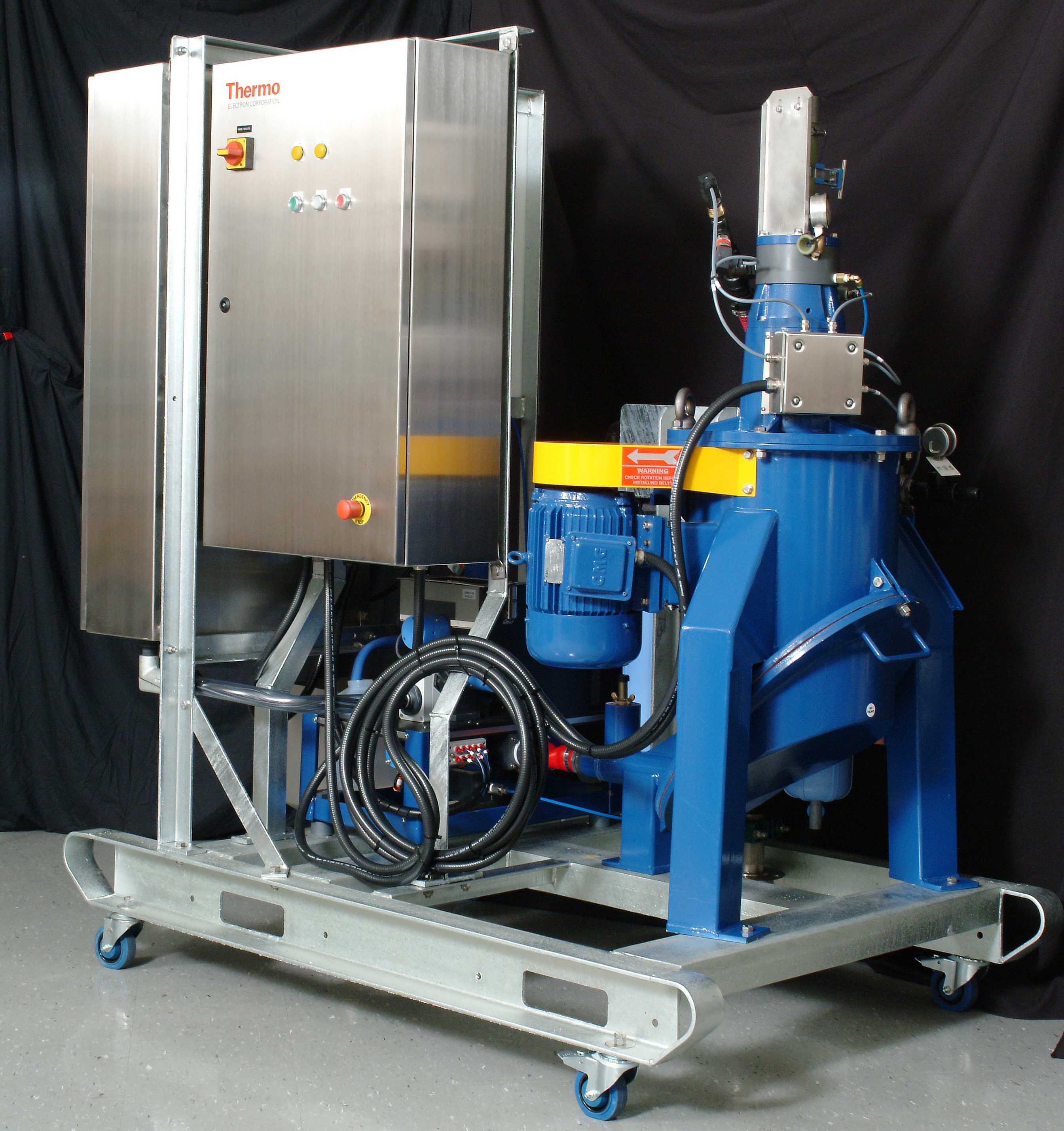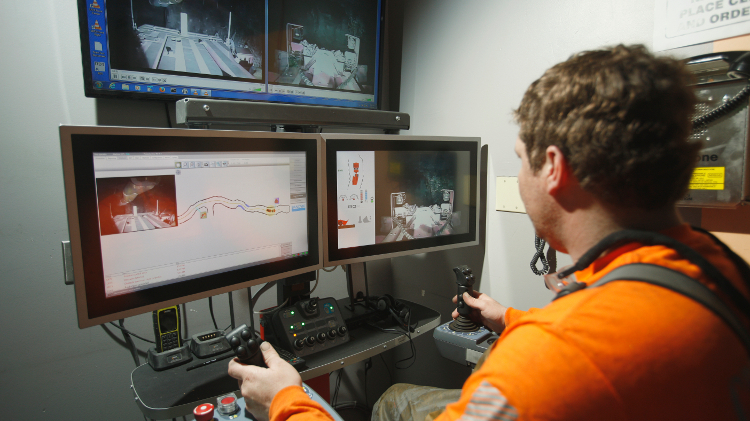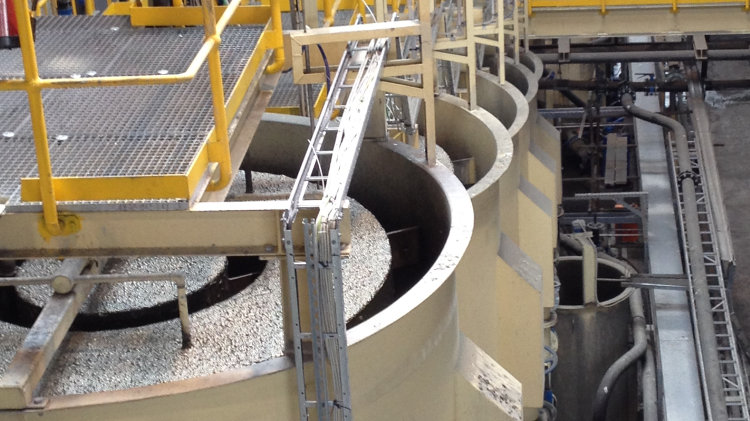The two-mass vibrating screen from General Kinematics, shown here being installed in China, is designed to handle higher thoughput without needing more power or space. Courtesy of General Kinematics
Larger mines, lower commodity prices, and new technologies all put pressure on mill operators to keep up. Controlling what goes into the plant, measuring what comes out and adjusting on the fly have all yielded performance improvements in operating mills thanks to their precision and efficiency.
Beyond brute force
As mines and mills get larger, so must the material handling and processing equipment. General Kinematics provides a solution to the problem of size limits in brute-force vibrating screens. Their two-mass vibrating screens, which use a second mass set on reactor springs that moves in the opposite direction as the screen below, are designed to have a natural frequency near the frequency at which they operate. Doing so allows their screens to use smaller motors and exciters – often just a third of the size and power of an equivalent sized brute-force screen, leading to drastically lower energy consumption.
“There are limits to how high you can go with a brute-force drive. If we’re doing the same amount of work with a third of the horsepower and a third of the drive, in theory we can get up to three times the size,” said Steve Massman, technical director at General Kinematics. “Lower horsepower also means smaller motors, which means easier and less costly replacement of the motors and drive components.”
Massman and Edward Wipf, president of EdRockMan IV, consultants who represent General Kinematics in the mining industry, spoke to CIM Magazine about the equipment. “In one of our installations, a coal plant in Australia,” Wipf said, “the screen was able to do up to 40 per cent higher throughput in the same footprint as the original brute-force screen, at the same screen efficiency.”
The screens are also better equipped to handle material surges. Adding material to the screen increases the effective weight of the system, moving the natural frequency of the screen closer to its operating speed. That causes the stroke to actually increase under load, rather than bogging down.
“By divorcing the motors from the body that is handling the material, impact forces on the motors are lower, too,” said Massman. This increases the life of the motors and drives.
The opposing motion of the screen and the mass also decreases the live load transmitted to the foundation. “In a normal screen, there’s the weight of the screen, but also 150 to 350 per cent extra loading due to the dynamic forces that go into the foundation,” noted Wipf. “Here it’s only the static weight plus about 25 per cent.”
Lower foundation construction costs can offset the slight price premium of two-mass screens, which run about 1 to 1.2 times the cost of a single-mass screen with the same screen area. “They can be very comparable in price,” said Wipf, “because the two-mass screen technology can give you 20 to 40 per cent higher throughput in the same floor space. You’ll also be saving a lot on the energy, on the screen media, and on the maintenance.”
As operators require ever larger throughputs, General Kinematics is currently constructing their largest version yet, with a screen measuring 5.3 metres wide by 7.3 metres long. They claim it is the largest vibrating screen in existence anywhere. The modular design, however, means that the larger scale does not present outsized logistical challenges.
Predictive control
More data and better equipment are only as good as the people and algorithms controlling the process. Honeywell’s multivariable predictive control technology (MPC) promises to operate a process closer to its limits, maximizing capacity or recovery as desired by the operator. The controller takes historical data from the process and creates a model that correlates the various parameters – generally 10-15 control variables and six to eight outputs in a grinding circuit, but up to 80 inputs and 20-30 outputs in other processes – allowing the effects of ore and set-point changes to be predicted.
Although it is relatively new to larger Canadian grinding and flotation systems, Honeywell’s MPC has been installed in over 100 grinding circuits worldwide since 1997, as well as in other areas of mineral processing, petroleum refineries, and other industrial plants. In the average milling application, MPC has been in use for eight years at a utilization rate north of 90 per cent, noted Bob Jonas, Honeywell Process Solutions’ mining and metals business development manager.
“MPC was implemented in the grinding circuit at Agnico Eagle’s Goldex mine in June 2015, controlling the SAG mill and classification. Later the ball mill and ore blending was added, in total, taking in ten inputs (measured values) and controlling nine outputs,”said Jonas. “The system is used over 90 per cent of time, resulting in 35 per cent fewer set-point changes required by operator, increase in gold recovery of 0.85 per cent, and,” he added, “the system paid for itself within a year,” referring to recently published results by Agnico Eagle.
At Goldex, the MPC was implemented over eight days. During the first four-day visit, during which time its historical process data was collected to automatically learn the various interactions. “When the ore feed changes, how does that affect the power of the mill?” asked Jonas. “The system identifies all those interactions automatically, in a very precise way. Then it tells the engineer any areas where it was unable to establish relationships, identifying a need to fix instrumentation or need to get better data.” During the second site visit at Goldex, the operator made some set-point adjustments to provide data to the MPC to learn the missing relationships, and then the MPC controller was commissioned.
In a milling process, Honeywell typically optimizes the algorithm to increase ore tonnage using a simple principle. “When things are stable, when load, power and other limits are not exceeded, add ore,” said Jonas. “Customers will regularly see two to six per cent higher throughput, and sometimes as high as 10 to 20 per cent higher using predictive control.” At Goldex, however, challenged by lack of ore, the MPC is instead optimized to stabilize the process and get a more uniform grind size, helping optimize downstream processes like recovery in the flotation cells.
“The MPC, using predictive control, knows very precisely the effect of each parameter. It will tend to ramp the changes in a very smooth manner, in the course of just a couple minutes. It does this in a responsive way to maintain control, but also in a stabilizing manner that contributes to a more uniform grind size.”
By contrast, Jonas said, “a normal controller uses only feedback. It makes a change, and then waits to see how that affects the other parameters of the system. If there is a delay – it can take 10 to 30 minutes to see the full effect of a change – the controller can’t make all the desired changes at once.” Because of the risk of upsetting the process if it overshoots, a normal controller is very conservative when making changes and does not do a good job of stabilizing, he said.
Particle size analysis
Agnico Eagle has improved throughput in the grinding circuit at its Meadowbank mine by collecting more data on the size of the particles leaving their mill. Frequent changes in hardness caused by varying ore types makes optimizing recovery challenging. Thermo Fisher Scientific’s PSM-400MPX on-line ultrasonic particle size analyzer helps Agnico stay within limits. Particle size analysis at Meadowbank reduced grind size to 4.4 microns, increased mill throughput by nearly seven tonnes per hour, and improved recovery at the mine by 0.64 per cent, to the tune of an extra 249 ounces of gold per month, according to a paper presented at the 49th annual Canadian Mineral Processors Conference (CMP 2017).
 Thermo Fisher Scientific’s particle size monitor PSM-400MPX is deployed at Agnico Eagle’s Meadowbank mill. Courtesy of Thermo Fisher Scientific
Thermo Fisher Scientific’s particle size monitor PSM-400MPX is deployed at Agnico Eagle’s Meadowbank mill. Courtesy of Thermo Fisher Scientific“When metal prices are low and operators are struggling to make profit, their attention turns back to being better operators rather than just pushing throughput,” said Tom Strombotne, global product manager for minerals at Thermo Fisher. “On-line particle size analysis can be used by operators to establish that they’re achieving the target grind in real-time, or to maximize throughput through the mill while keeping the grind below some absolute maximum size for downstream processes.”
Currently, this fourth-generation particle size monitor can measure five discrete particle size fractions over the full particle size distribution, as well as the per cent solids in the slurry. Although the product has been on the market for nearly ten years, this latest version offers Ethernet connectivity, an improvement on older analog systems. In the last five to eight years, added Strombotne, the company has paired the PSM with a SamStat multi-stage, static metallurgical accounting station. The SamStat has a primary sampling stage feeding a secondary sampling stage, which then provides a smaller, continuously flowing sampling zone from which the PSM can acquire a representative sample. “That’s one innovation that has made the technology amenable to the way higher-throughput modern plants are designed,” said Strombotne.
But the benefits do not happen by accident, he cautioned. “If you went around the globe and visited all the plants that have particle size analyzers, you would find a wide distribution of how effectively they are employed,” Strombotne said. At Meadowbank, emphasizing regular maintenance and cleaning of the PSM-400 and its Samstat-20 flow sampler corrected a scaling problem and ensured that the mine saw a rapid payback on the roughly $200,000 piece of equipment.
Thermo Fisher expects to work with operators to enhance the product further. “The future is bright in terms of exploiting the science of ultrasonic scattering to produce continuous particle size distribution on-line that doesn’t require calibrating against discrete sieves,” said Strombotne. Though mill operators and metallurgists say they would like that information, they are not yet sure how they would use it to make money. “It’s one thing to have the technological capability, but we have to figure out ways in which the information can be exploited.”
Further reading
Information on all of these technologies can be found within the proceedings of the 49th annual Canadian Mineral Processors Conference available at cmpsoc.ca.





